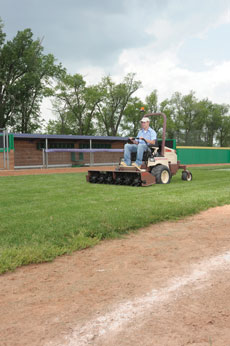Autumn turf rejuvenation is critical for drought-stricken areas (with related video)

While long-term effects of the 2012 drought have yet to be seen, short-term impacts are already clearly visible. With more than 60 percent of the U.S. locked in a cycle of “moderate” drought or worse, lawns and turf in these regions are suffering.
Lawns that receive a little extra attention this fall will have an advantage over lawns that are left to fend for themselves until spring. Because turfgrasses are 75 percent water, when the plant loses more water through the leaves than it absorbs through the roots, drought stress sets in. The grass eventually stops growing and enters a dormant state. While the plant may not be dead, taking appropriate action in the fall can help the turf recover during the winter and come back rejuvenated in the spring.
Moundridge, Kan.-based Grasshopper Company recommends the following steps to nurse drought-stricken turf areas back to health:
Mow higher — Though fall rains can spur vigorous blade growth, resisting the urge to mow can be beneficial. Drought stress is not eliminated after one or two waterings or rain showers, so give the turf some additional time to encourage root growth and depth before mowing. Apply the “1/3 Rule” — remove the top third of the blade height – when mowing to avoid additional stress.
Remove thatch layer — Thatch build-up can prevent water and nutrients from absorbing into the soil where the plant roots need it most. Use a thatch remover, like the Tine-Rake Dethatcher for Grasshopper mowers, to lift the thatch from the turf. Collect the thatch and use as compost.
Aerate, Aerate, Aerate — Jason Potthoff of JP Lawn Care, a landscape contractor in Winamac, Ind., says aeration is key to any healthy lawn. He recommends aerating twice a year, in the fall and spring, and especially after a drought. “Aerating relieves soil compaction, encourages root growth, improves water absorption and prepares the soil for overseeding and fertilizing,” he says. Potthoff uses the AERA-vator implement for his Grasshopper mower, which makes aerating and conditioning the soil quick, thorough and easy.
Overseed and/or Fertilize — Overseed to fill in thin or bare areas, and apply a starter fertilizer with higher levels of phosphorus to establish the new root system. If the lawn does not require overseeding, simply apply a fertilizer with higher levels of nitrogen, which will encourage growth and recovery. Grasshopper offers a drift-control Shielded Sprayer for on-target chemical application and less labor than backpack sprayers or walk-behind granular spreaders.
To learn more about these implements that make turf rejuvenation easy and effective, as well as the line of Grasshopper True ZeroTurn mowers, visit Grasshopper at GIE+EXPO — Booth 9130 inside, 7542-D outside — in Louisville, Ky., Oct. 25-26, or go online here.
Watch a video of the AERA-vator as it aerates and conditions turf.




















